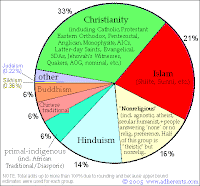Hinduism in Nashville
During our exploration of the Nepalese culture, Team Nepal was able to visit Nashville's very own Hindu temple, Sri Ganesha Temple. Here, students were able to explore Hinduism and become better acquainted with the primary religion of Nepal.
Hinduism

Hinduism Fast Facts
Major sects: Saivism, Vaisnavism, Saktism
Sacred texts: Vedas, Upanishads, Sutras, Bhagavad GitaSpiritual leader: Guru or safe
Place of worship: Temple or home shrine
Ultimate reality: Brahman
Human nature: In bondage to ignorance and illusion but able to escape
Purpose of life: To attain liberation (moksa) from cycle of reincarnation
How to live: According to the dharma
Afterlife: If karma is unresolved, soul is born into a new body; if karma is resolved, attain moksa
History
- Hinduism is the oldest living major religion (earliest evidence dates back 1500 BC or earlier)
- Predominant and indigenous religious tradition of Indian subcontinent
- Third largest religion after Christianity and Islam with 900 million followers worldwide
Is Hinduism a religion?
- Religious tradition characterized by comprehensive tolerance to differences in belief that grants absolute and complete freedom of belief and worship
- No single or common historical founder
- Enormous variety of religious traditions
- No concept of a prophet
- No central religious authority
- No single holy text
- Concept of God is complex and depends on each particular tradition and philosophy (denominations span monotheism, polytheism, panentheism, pantheism, monism, atheism, agnosticism, Gnosticism)
- -Most denominations are henotheistic: Recognize a single deity (Shiva, Vishnu, Brahman) with other gods/goddesses as manifestations of that supreme god
Purusharthas: The objectives of human life
- Dharma: “Righteousness” of religious life
- Artha: “Livelihood” and success in economic life
- Kama: “Sensual pleasure”
- Moksa: “Liberation, freedom”
Ten Commitments
- Ahimsa: Do no harm
- Satya: Do not lie
- Asteya: Do not steal
- Brahmacharya: Do not overindulge
- Aparigraha: Do not be greedy
- Saucha: Be clean
- Santosha: Be content
- Tapas: Be self-disciplined
- Svadhyaya: Study
- Ishvara Pranidhana: Surrender to God
4 Stages (Ashramas) of Life
- Brahmacharga: takes place during the school years, focused on acquiring knowledge and developing character
- Grastha: The middle years, focused on worldly pursuits and pleasures such as marriage, family and career
- Vanaprastha: When one's children reach adulthood, a time of increased focus on spiritual things
- Sanngasu: In the last years of life, one may abandon the world entirely for a life of contemplation.
Practices/Rituals
- Symbolism and iconography to represent the sacred (art, architecture, literature, and worship)
- Gain meaning from scriptures, mythology, cultural traditions
- Mantras: Invocations, praise, and prayers that help focus the mind on holy thoughts or expression of devotion to God/the deities
- Rituals are observed on a daily basis that vary among regions, villages, and individuals
- Purity versus pollution: Often rituals presuppose a degree of impurity for the practitioner which must be overcome/neutralized before or during the procedures
- Birth, marriage, and death involve elaborate sets of religious customs
Scriptures
Based on accumulated knowledge of spiritual laws discovered by different persons in different times that are important guides for ethics
Divided into 2 main classes:
- Shruti: “That which is heard” refers to the Vedas (earliest record of Hindu scriptures) include the laws of the spiritual world
- Smritis: “Remembered” texts that include the epics, philosophical teachings from Krishna




No comments:
Post a Comment